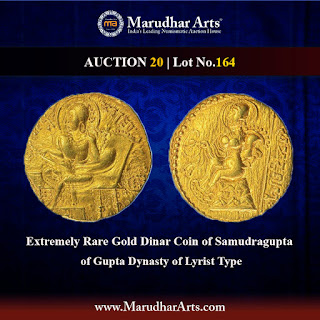 |
| Coin of Chandragupta |
Gupta Dynasy, Chandragupta II (Vikramaditya) (375-415 AD), Gold Dinar, Archer Type, Unusual Variety of Reverse Archer and Reverse Face, Obv: king standing to right looking backwards to left with the body also turned one fourth to the left, wearing janghia and sash with the upper half body and the head bare only, holding arrow in right hand and the left hand is seen holding the bow at center from inside the string, bow is also reverse than of usual right, garuda standard Garuda dwhaja, Chandra outside the bow-string, circular brahmi legend 'Devasrimaharajadhirajadhirajasri-Chandraguptah', Rev: goddess lakshmi seated facing on a lotus in padmasana, holding noose in her right hand and lotus in left whose stem is coming from inside the hand resting on the thigh, tamgha to left with brahmi legend ‘Sri Vikramah’, 7.74g, 18.01mm, (Altekar, Bayana Hoard # Pl. XIII-5), about extremely fine, Extremely Rare.
Many coins are reported in Chandragupta II with the reverse face but this combination of reverse face and reverse archer is offered for the first time. The interesting thing to note here is that the bow is held by king in reverse position and his hand is coming within the bow and resting at the center of the bow. Usually what we see is the reverse looking king with his hand going up and holding the bow from the top but this specimen has the hand coming to the down holding the bow from the center. The bow is seen resting on the shoulders of the king. And if the reverse is observed than the lotus stem will be seen going from inside the lower part of hand to the top. This type of the king’s position makes this specimen amazing. Lovely artistic features overall on this beautiful specimen.
BMC catalog does not list this in their collection ,very interesting specimen missing from various collections.






